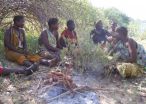(Press-News.org) The paradox of happiness is that chasing it may actually make us less happy, a Stanford researcher says.
So how does one find happiness? Effective ways exist, according to new research.
One path to happiness is through concrete, specific goals of benevolence – like making someone smile or increasing recycling – instead of following similar but more abstract goals – like making someone happy or saving the environment.
The reason is that when you pursue concretely framed goals, your expectations of success are more likely to be met in reality. On the other hand, broad and abstract goals may bring about happiness' dark side – unrealistic expectations.
Those are the conclusions of a study recently published in the Journal of Experimental Social Psychology by Jennifer Aaker, a social psychologist and the General Atlantic Professor of Marketing at Stanford Graduate School of Business. Co-authors are Melanie Rudd, an assistant professor of marketing at the University of Houston, and Michael Norton, an associate professor of business at Harvard University. Rudd, who studied under Aaker at Stanford as a doctoral student, was the lead author on the study.
As the researchers point out, the pursuit of happiness is one of the most essential quests in life, and happiness is often considered a hallmark of psychological health. But it is more mysterious and complex than most people might imagine – and not always readily achievable.
Aaker said, "Although the desire for personal happiness may be clear, the path to achieving it is indefinite. One reason for this hazy route to happiness is that although people often think they know what leads to happiness, their predictions about what will make them happy are often inaccurate."
One underappreciated way to increase one's own happiness is to focus on elevating the happiness of others. But, how exactly do you do that? Are some acts of benevolence better able to increase personal happiness than others?
To answer this question, the researchers conducted six experiments involving 543 people from laboratory studies and national survey pools. The level of abstraction of one's "prosocial" goal was the critical factor of interest. Prosocial acts are defined as voluntary behavior intended to benefit someone else.
'Concrete' happiness
The results show that acts designed to improve the well-being of others will lead to greater happiness for givers when these acts are associated with concretely framed, prosocial goals as opposed to abstractly framed prosocial goals – despite people's intuitions to the contrary.
For example, an experiment involving bone marrow transplants focused on the whether giving those who need bone marrow transplants "greater hope" – the abstract goal – or giving those who need bone marrow transplants a "better chance of finding a donor" – the concrete goal – made a giver more happy.
The answer: Helping someone find a donor resulted in more happiness for the giver. This, the researchers wrote, was driven by givers' perceptions that their actual acts better met their expectations of accomplishing their goal of helping another person.
Discrepancies in expectations and reality
Rudd, Aaker and Norton show that these "happiness effects" are due to smaller gaps between one's expectations of achieving the goal and the actual result when one's goal is framed more concretely. Simply, the more abstract goals are often more unrealistic.
Is prosociality always a good goal to chase? According to this study, the answer is: It depends. Sometimes people pursue prosociality in a way that is less than optimal.
Rudd explained, "Discrepancies between aspirations and reality can be critical factors that, in extreme cases, may even lead the act of helping to eventually becoming a source of unhappiness."
For example, when people pursue abstract prosocial goals and expect their relentless giving to result in tremendous and rapid change for the better – and it fails to materialize – they can suffer from "helper burnout," which can negatively impact happiness.
But, encouraging givers to "reframe their prosocial goals in more concrete terms" would allow expectations to be better calibrated, increasing personal happiness, the researchers argue.
Givers are likely to experience greater happiness if they frame their prosocial goals in concrete rather than abstract terms, according to the authors.
Business nuances
The results have implications for the world of business. For instance, marketing or products that claim to help consumers achieve abstractly framed goals – like making someone else happy – might not be the best business decision. Instead, it might be wiser to reframe these promised goals in more specific, concrete terms.
Consider, for example, Tom's Shoes. The company promises that if a customer buys a pair of shoes, they will deliver another pair to a child in need.
"Concrete initiatives such as this may be a more realistic way to accurately set consumers' expectations from the outset and leave them happier in the end," Aaker said.
Boosting happiness
Ultimately, people seek to be happy, and one clear path toward happiness is through prosocial behaviors.
Aaker explained, "A prosocial act can not only boost the happiness of the recipient, but it can boost the happiness of the giver as well."
"However," cautioned Rudd, "not all prosocial goals are created equal."
The researchers hope that future work will yield a deeper understanding of how to harvest happiness – such as by helping others – and how to avoid any unhappiness traps along the way. Sometimes, people pursue happiness ineffectively – as in giving to well-intentioned but broadly defined causes – which may leave them dissatisfied.
As Aaker noted, people often do not realize why they are left feeling unfulfilled – leading them to repeat their mistakes in the future.
But, on the bright side, greater happiness is just within reach when the goal of giving is realistically focused and viewed through a concrete lens.
INFORMATION:
Media Contacts
Jennifer Aaker, Graduate School of Business: (650) 724-4440 jaaker@stanford.edu
Clifton B. Parker, Stanford News Service: (650) 725-0224, cbparker@stanford.edu
Cultivating happiness often misunderstood, says Stanford researcher
Stanford research explores the concept of maximizing happiness
2014-04-15
ELSE PRESS RELEASES FROM THIS DATE:
Lifestyle determines gut microbes
2014-04-15
This news release is available in German. The gut microbiota is responsible for many aspects of human health and nutrition, but most studies have focused on "western" populations. An international collaboration of researchers, including researchers of the Max Planck Institute for Evolutionary Anthropology in Leipzig, Germany, has for the first time analysed the gut microbiota of a modern hunter-gatherer community, the Hadza of Tanzania. The results of this work show that Hadza harbour a unique microbial profile with features yet unseen in any other human group, supporting ...
Real-time audio of corporal punishment shows kids misbehave within 10 minutes of spanking
2014-04-15
A new study based on real-time audio recordings of parents practicing corporal punishment discovered that spanking was far more common than parents admit, that children were hit for trivial misdeeds and that children then misbehaved within 10 minutes of being punished.
Advocates of corporal punishment have outlined best practices for responsible spanking. But real-time audio from this study revealed that parents fail to follow the guidelines, said psychologist George Holden, who is lead author on the study and a parenting and child development expert at Southern Methodist ...
Breaking bad mitochondria
2014-04-15
Researchers at the University of California, San Diego School of Medicine have identified a mechanism that explains why people with the hepatitis C virus get liver disease and why the virus is able to persist in the body for so long.
The hard-to-kill pathogen, which infects an estimated 200 million people worldwide, attacks the liver cells' energy centers – the mitochondria – dismantling the cell's innate ability to fight infection. It does this by altering cells mitochondrial dynamics.
The study, published in today's issue of the Proceedings of the National Academy ...
Computerized counseling reduces HIV-1 viral load, sexual transmission risk
2014-04-15
Antiretroviral therapy (ART), the primary type of treatment for the human immunodeficiency virus (HIV), can reduce sexual transmission, prevent illness, and increase longevity and quality of life for patients. However, according to current data, only an estimated 77-percent of U.S patients on ART therapy have suppressed viral loads. This suggests patients' adherence to the current ART treatment regiments is in need of improvement to reduce the viral load and also to lower sexual transmission risk behaviors.
Now, new research from faculty affiliated with New York University's ...
Rethink education to fuel bioeconomy, says report
2014-04-15
Microbes can be highly efficient, versatile and sophisticated manufacturing tools, and have the potential to form the basis of a vibrant economic sector. In order to take full advantage of the opportunity microbial-based industry can offer, though, educators need to rethink how future microbiologists are trained, according to a report by the American Academy of Microbiology.
"Industrial microbiology is experiencing a Renaissance; microorganisms make products ranging from the tightly regulated pharmaceuticals industry to large-scale production of commodity chemicals and ...
UC research illuminates 'touchy' subject
2014-04-15
By solving a long standing scientific mystery, the common saying "you just hit a nerve" might need to be updated to "you just hit a Merkel cell," jokes Jianguo Gu, PhD, a pain researcher at the University of Cincinnati (UC).
That's because Gu and his research colleagues have proved that Merkel cells— which contact many sensory nerve endings in the skin—are the initial sites for sensing touch.
"Scientists have spent over a century trying to understand the function of this specialized skin cell and now we are the first to know … we've proved the Merkel cell to be a primary ...
Predicting bioavailable cadmium levels in soils
2014-04-15
New Zealand's pastoral landscapes are some of the loveliest in the world, but they also contain a hidden threat. Many of the country's pasture soils have become enriched in cadmium. Grasses take up this toxic heavy metal, which is then eaten by the cattle and sheep that graze them. The problem is not unique to New Zealand; cadmium-enriched soils being reported worldwide.
The concern is that if cadmium concentrations rise to unsafe levels in meat and dairy products, human health and New Zealand's agricultural economy could be jeopardized. That so far hasn't happened.
But, ...
Remnants of Tropical Depression Peipah still raining on Philippines
2014-04-15
Several regions in the south and central Philippines have flood advisories as the remnants of now dissipated Tropical Depression Peipah continue to linger over the country. NASA-NOAA's Suomi NPP satellite got a look at the remnant clouds from its orbit in space on April 15.
The Visible Infrared Imaging Radiometer Suite (VIIRS) instrument aboard NASA-NOAA's Suomi NPP satellite captured a look at Peipah's remnant clouds on April 15 at 5:44 a.m. EDT. VIIRS collects visible and infrared imagery and global observations of land, atmosphere, cryosphere and oceans. The VIIRS ...
Study examines Vitamin D deficiency and cognition relationship
2014-04-15
WINSTON-SALEM – April 15, 2014 – Vitamin D deficiency and cognitive impairment are common in older adults, but there isn't a lot of conclusive research into whether there's a relationship between the two.
A new study from Wake Forest Baptist Medical Center published online ahead of print this month in the Journal of the American Geriatrics Society enhances the existing literature on the subject.
"This study provides increasing evidence that suggests there is an association between low vitamin D levels and cognitive decline over time," said lead author Valerie Wilson, ...
NASA's TRMM Satellite adds up Tropical Cyclone Ita's Australian soaking
2014-04-15
After coming ashore on April 11, Tropical Cyclone Ita dropped heavy rainfall over the weekend that caused flooding in many areas of northeastern Australia's state of Queensland. The Tropical Rainfall Measuring Mission satellite known as TRMM gathered data on rainfall that was used to create a rainfall map at NASA.
TRMM is a satellite managed by both NASA and JAXA, the Japan Aerospace Exploration Agency. At NASA's Goddard Space Flight Center in Greenbelt, Md. Hal Pierce created a TRMM-based near-real time Multi-satellite Precipitation Analysis (TMPA). The TMPA precipitation ...
LAST 30 PRESS RELEASES:
Scientists boost cell "powerhouses" to burn more calories
Automatic label checking: The missing step in making reliable medical AI
Low daily alcohol intake linked to 50% heightened mouth cancer risk in India
American Meteorological Society announces Rick Spinrad as 2026 President-Elect
Biomass-based carbon capture spotlighted in newly released global climate webinar recording
Illuminating invisible nano pollutants: advanced bioimaging tracks the full journey of emerging nanoscale contaminants in living systems
How does age affect recovery from spinal cord injury?
Novel AI tool offers prognosis for patients with head and neck cancer
Fathers’ microplastic exposure tied to their children’s metabolic problems
Research validates laboratory model for studying high-grade serous ovarian cancer
SIR 2026 delivers transformative breakthroughs in minimally invasive medicine to improve patient care
Stem Cell Reports most downloaded papers of 2025 highlight the breadth and impact of stem cell research
Oxford-led study estimates NHS spends around 3% of its primary and secondary care budget on the health impacts of heat and cold in England
A researcher’s long quest leads to a smart composite breakthrough
Urban wild bees act as “microbial sensors” of city health.
New study finds where you live affects recovery after a hip fracture
Forecasting the impact of fully automated vehicle adoption on US road traffic injuries
Alcohol-related hospitalizations from 2016 to 2022
Semaglutide and hospitalizations in patients with obesity and established cardiovascular disease
Researchers ‘listen in’ to embryo-mother interactions during implantation using a culture system replicating the womb lining
How changing your diet could help save the world
How to make AI truly scalable and reliable for real-time traffic assignment?
Beyond fragmented markets: A new framework for efficient and stable ride-pooling
Can shape priors make road perception more reliable for autonomous driving?
AI tracks nearly 100 years of aging research, revealing key trends and gaps
Innovative techniques enable Italy’s first imaging of individual trapped atoms
KIER successfully develops Korea-made “calibration thermoelectric module” for measuring thermoelectric device performance
Diversifying US Midwest farming for stability and resilience
Emphasizing immigrants’ deservingness shifts attitudes
Japanese eels, climate change, and river temperature
[Press-News.org] Cultivating happiness often misunderstood, says Stanford researcherStanford research explores the concept of maximizing happiness



